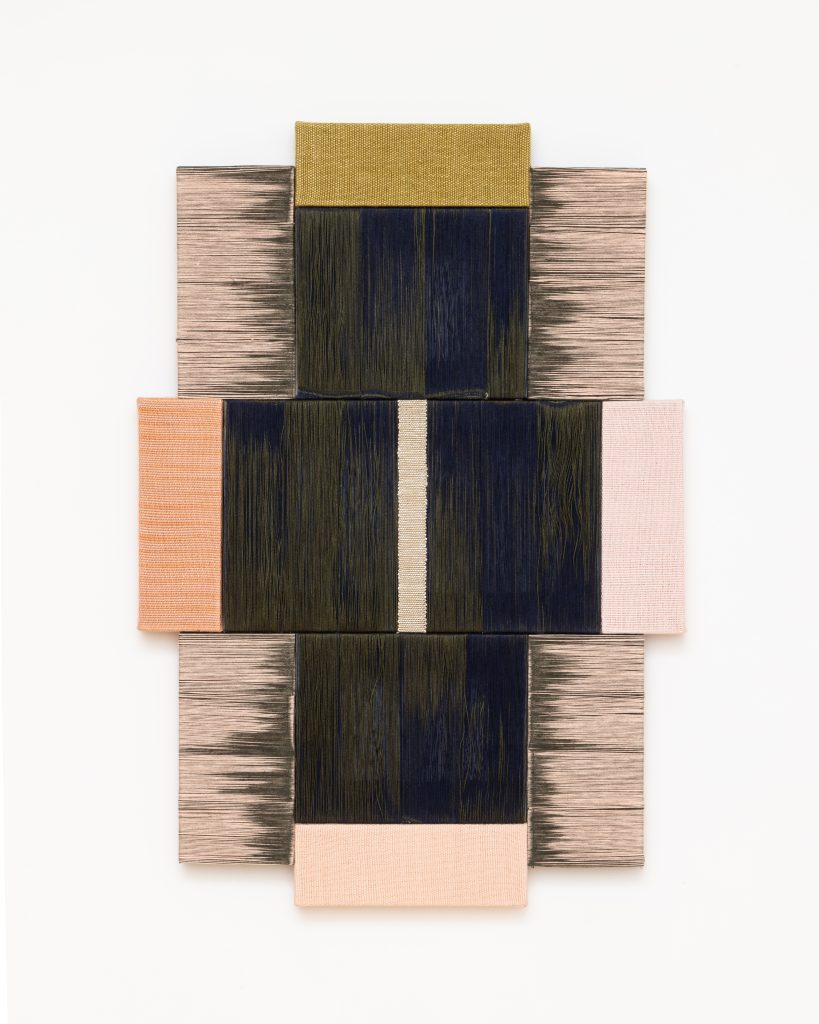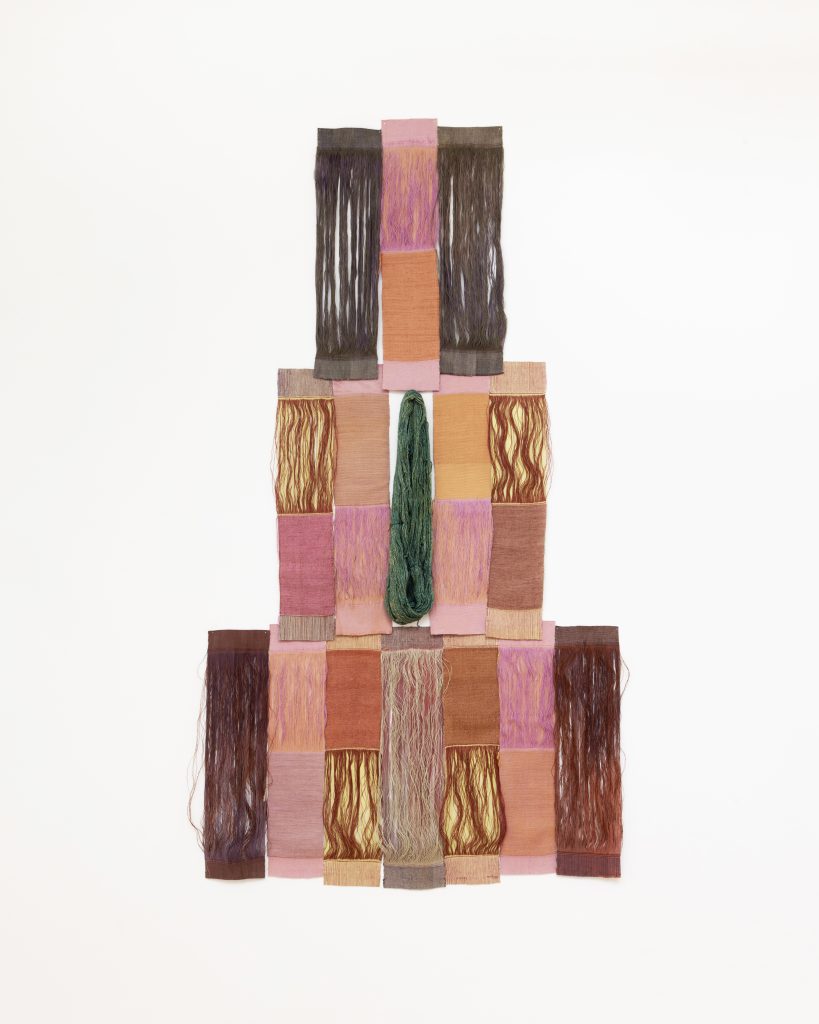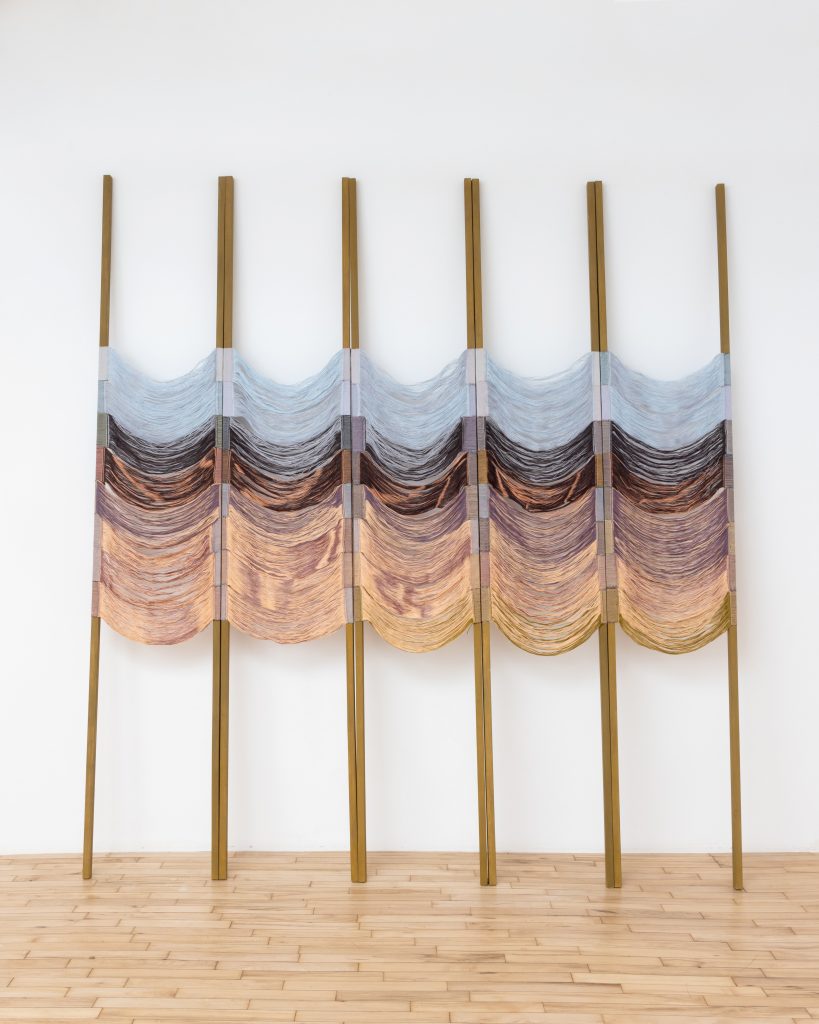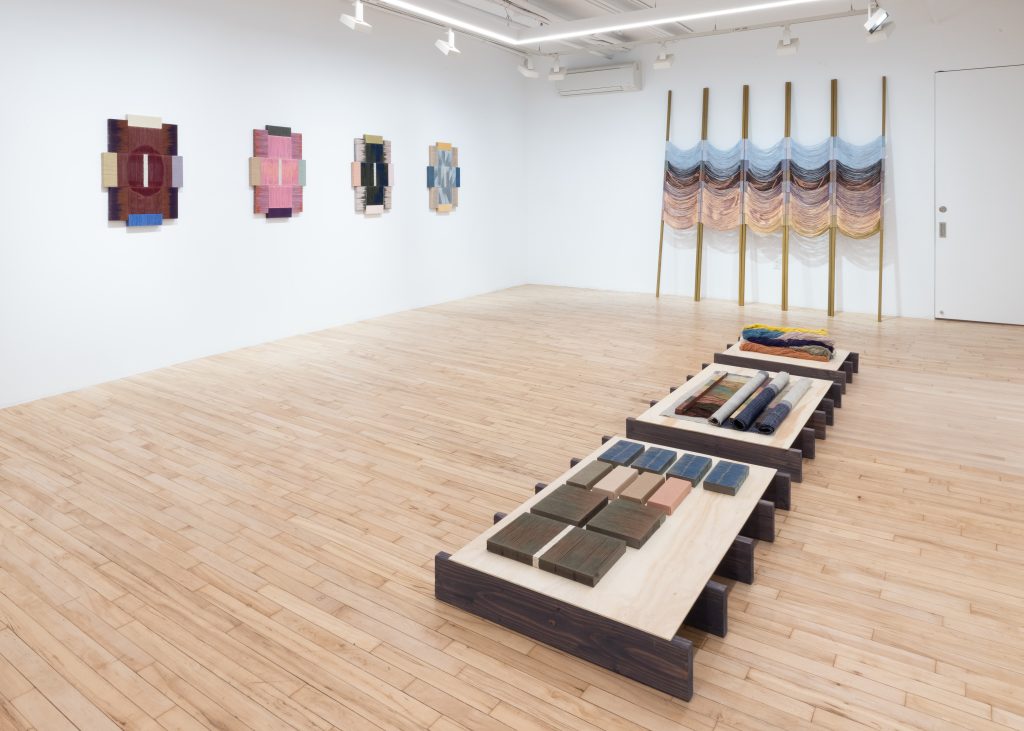I feel drawn in by the textile artworks from Carolina Jiménez in a new exhibition at HESSE FLATOW in New York City.
The art formulates and emphasizes a spatial, environmental structure: the spectacular and bold becoming accessible and embedded within a simple corner. Many of the exhibited works of art involve yarn woven to create blocks of flat surface and assembled together into a plane, like a slightly more tangible and a more embodied than usual map, something a discussion of the show shared by the gallery points out. (Curator Kiko Aebi wrote that text, discussing the “vaguely topographic abstractions.”) Aesthetically, the art’s forms hearken to at least our experience of what’s outside of us, tangibly and physically. Space tends to grow outwards, establishing within itself a kind of reassuring cohesion, an image of itself — outside of us — that gives us some semblance of place.
And if that wasn’t already happening in the real-world spaces around us, it’s happening in this art, though what Jiménez put together feels emotionally realistic and honest in its expression, even as it relays a story that extends well outside of the level of the individual.
The geometric specificity of Jiménez’s visual aesthetic in this moving exhibition — blocks of yarn, woven in a pattern putting each length of it parallel to the next — cultivates and enmeshes you while looking at this into a sense of specific, external place. And for the artist, she was drawing from specific locations in assembling these works. “Alone (with you) at the Pond” (2025), which features the exhibition’s yarn now hanging loosely between gently leaning pine beams, refers in its title to a body of water at the Albers Foundation up in Connecticut, where she was awarded a residency.
Jiménez also utilized natural dyes in infusing her yarn with color, and the palette — like another recent exhibition at Pace featuring artist Kylie Manning, who also used some natural pigments — feels… connected. There’s some level of recognition between yourself and the art, even if it’s not something you’ve ever seen or even a specific kind of art you’ve necessarily witnessed before. You nonetheless start to recognize it — the gentle flow of these works, their textures and unassuming forms, starting to strike you as familiar. It’s a kind of inwardly billowing recognition that transcends specifics.
Looking at these artworks, I’ve never been to specific places that Jiménez is recollecting and reformulating, but I’ve been… present, and the artist transmuted and relayed a sense of presence, now with knowledge of presence — the broader perspective of seeing and being in a place, and the vision of how it fits into a story, all in view. The momentary becomes… lasting. And across the full sweep of the experience, the spatial and structural — that in the art which feels like it’s establishing our visual path of progression, or like it’s pointing to what holds a similar role in the external world — is granted the delicacy and gentility of a moment in the first place. Jiménez’s artworks are sweeping, but in each instance, with each glance across their breadths, they’re meeting you.
The sweeping and magisterial — the story of our lives and movements that tends to feel like it’s moving outwards and away from us in each instance, something more than us as any individual — it’s… here.
Structurally speaking, there’s a lot of space in these artworks. The parallel threads of yarn lay next to each other rather than smothering those that lie next to them, and while formidable across their entireties, the artworks’ overarching forms also land with a certain carefulness. They’re aesthetically extremely accessible — sometimes genuinely large, even surprisingly so, but always allowing for you to easily take them in, visually. They don’t encumber; they rest, planted and growing. They’re visually ensnaring, and in the visual presence and feeling of space within these artworks, they draw you in.
The physical occupation of a place becomes something relational as much as it’s a matter of simple points in space. It’s communication, though not necessarily something cyclical or altering, at least immediately. It’s a matter of just being there. In this art, space — the basics of the locations around us, in their corners and edges and expanses: it’s simply there with you, and the two — the place and its occupant — are inseparable, weaving together.
I’m also struck by the embodiment of multiplicity and potential within this exhibition. It’s not so much a series of neat options as it is the infusion across your view and vantage point of the knowledge that change and impact, newness and duality: they’re all within reach, moving into view if not here already. Place is melded, held, treasured, and pondered more than it’s simply taken at face value within the vista of this collection of artworks. We know ourselves to be fallible and fragile, but here, the place around us: it is too. We’re met more than we know, or let ourselves know.
Jiménez’s show continues through April 26 at HESSE FLATOW.



Featured image: Carolina Jiménez: “All That We Carry” (installation view), HESSE FLATOW, New York, March 21 – April 26, 2025. Courtesy of the artist and HESSE FLATOW, New York. Photo: Jenny Gorman
You may also like
-
Diana Kurz at Lincoln Glenn in New York: A Review of a Shining Art Exhibition
-
Dustin Hodges at 15 Orient in New York City: An Ensnaring Exhibition at an Exciting Gallery
-
Maren Hassinger at Susan Inglett Gallery in New York: Reviewing an Uplifting Art Exhibition
-
Enzo Shalom at Bortolami in New York City: Reviewing an Entrancing Exhibition of Paintings
-
“Ben Werther: Townworld” at Amanita in New York City: Reviewing a Richly Memorable Art Exhibition
